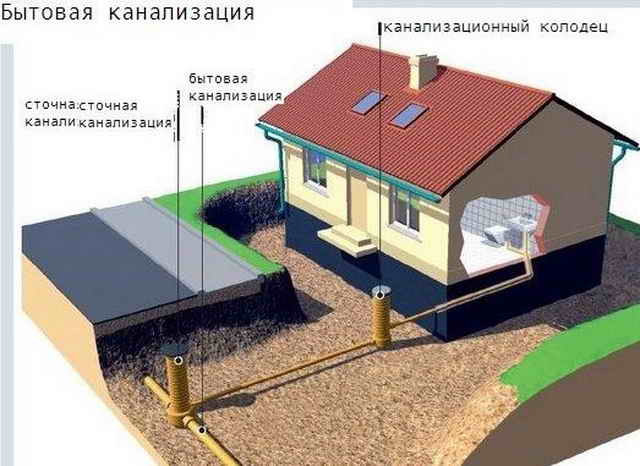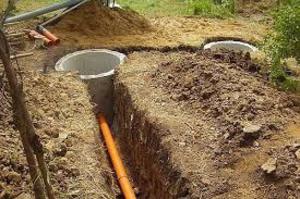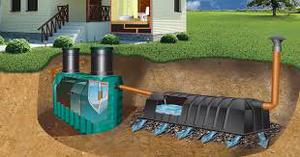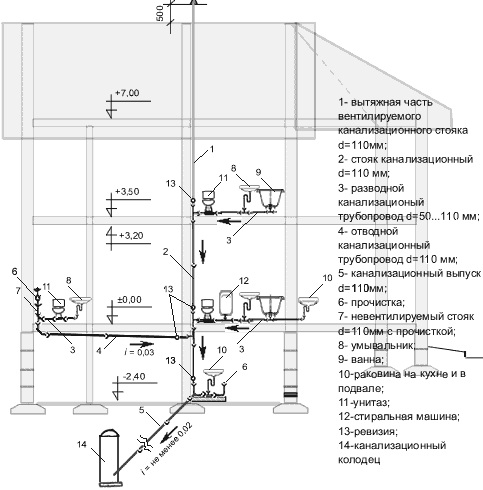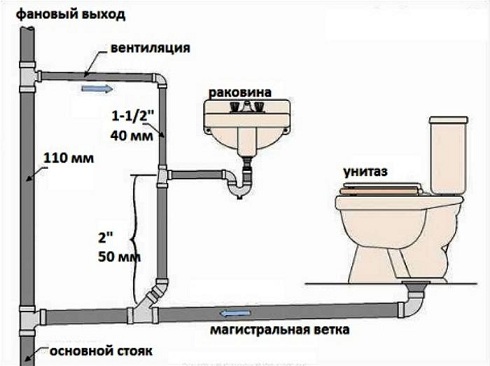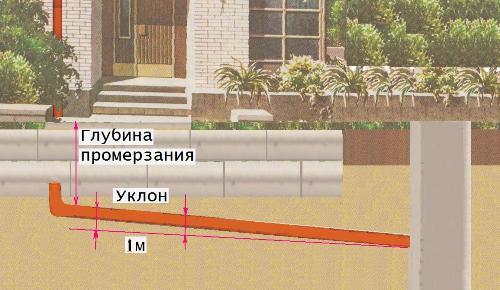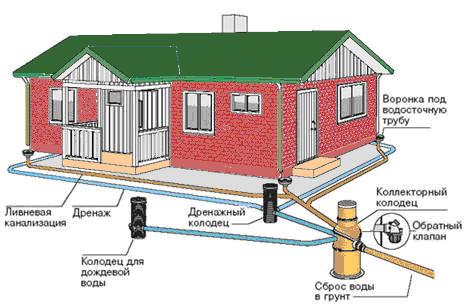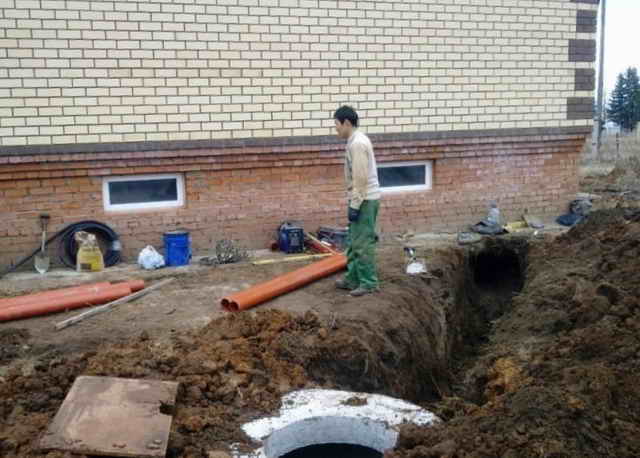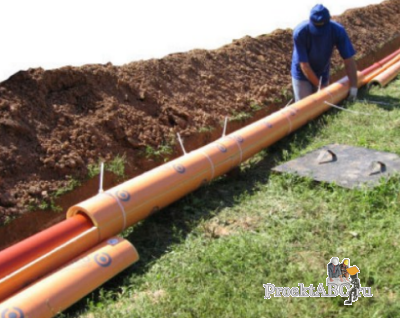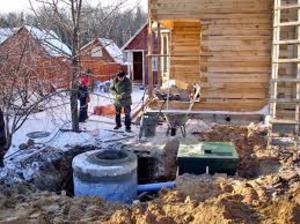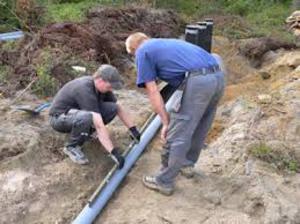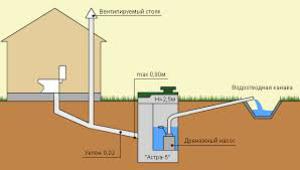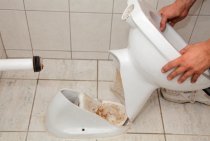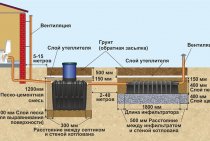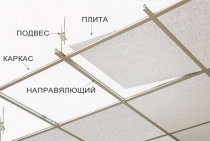Connection to sewerage networks, what documents are required
Finished house plan. Mandatory, on paper, a diagram of the laying of a sewer pipeline must be presented. This process is carried out with the help of a company that conducts geodetic expertise.
All technical conditions for connecting sewerage. All these issues are considered by the organization.
The scheme on which the plan will be indicated, it is according to it that it is necessary to connect the sewer. This document must be provided by a specialist who designs and installs technical functions. It relies on the basis of the specification, thus producing a new plan.
The project, which is prepared in the water utility, with their approval. This process is carried out by architectural management.
It is also necessary to remember one main nuance. Before starting construction work, you must obtain permission from your neighboring residents. They are required to sign their consent. If additional questions arise regarding the pipeline that will pass through the places where other electrical or thermal networks have already been laid, then in this case, it is necessary to take another permit. It is necessary to require a special document in the organization. If the owner does not pursue certain requirements, he will have to pay a huge fine.
To lay the pipeline to the central highway, you need to take permission. If there is a well nearby. The pipe that will pass through the site to the well will be directed at a certain slope and angle. To determine the laying depth with accuracy, it is necessary to use the special values \u200b\u200bprovided by the data in SNiP.
There is also one main piece of advice to keep in mind. This question concerns the existence of existing curves on the track. As shown in practice, turns on the track should not exist, but if such a problem suddenly arises, then it is necessary to turn the highway a few degrees, about 90. It is also recommended to install an inspection well. Since, in this case, the well performs the function of control over this system.
A significant role is played by the correct selection of the height of the trench digging. Certain elements must be taken into account. The pipe diameter must be larger than the inner diameter. The usual size is up to 250 mm. Basically, pipes with a diameter of 150 to 250 mm are used. After the specialist decides on the size of the pipes, it is necessary to dig the bottom of the trench. As soon as the process is completed, the pillow can be provided for laying the pipeline.
Where to go for sewerage
water utility or garden partnership
First you need to contact the local administration, from there you will have to go to the geodetic service (order a situational plan for the site), to the water utility and SES. An application is submitted to the water utility in order to obtain technical conditions for connection. You need to have a copy of your passport and a document confirming the ownership of the house and land. If the pipeline has to be laid under the carriageway, a permit from the road authority will be required.
After the technical conditions are received, you can order a sewerage project. If it is created by third-party specialists, the finished document still needs to be approved by the water utility and companies whose communications take place near the house (gas service, RES, telephone service). The final approval takes place in the department of architecture of the local municipality.
For installation, you can also hire a contractor who has the appropriate approvals.But in any case, a tie-in to the general network is made by a specialist from a company servicing the municipal sewer system.
install an independent sewerage system.
Private sewer network project
Laying sewerage in a private house begins with the development of a project and estimate documentation.
Household sewer project
A domestic sewer project is a diagram that details where and how the main parts of the sewer network should be installed.
Private sewer network project
When designing domestic sewage, it is necessary to take into account:
the location of plumbing products inside the house. It is desirable that all sewer wiring in a private house be as close as possible to the previously installed central riser. This will avoid the use of additional equipment, significantly reduce the cost of purchasing and laying pipelines, reduce the risk of blockages and unpleasant odors;
Typical scheme of the internal sewer network
- sewer slope in a private house. If it is possible to build a gravity sewer system, it is not necessary to resort to a pressure type. Installing a sewer in a gravity-fed private house is much simpler and cheaper than a pressure one;
- sewerage depth in a private house. It is required that all pipelines and additional structures be reliably protected from freezing, which can lead to the complete incapacity of the system.
Basic rules for laying a sewer pipeline
Rain sewer project
The project of a private storm sewer, as well as a domestic one, includes the location of the main elements and recommendations for installing the system.
Typical design of a storm sewer system
For high-quality and uninterrupted operation of private sewage, it is better to develop all the necessary projects in cooperation with qualified specialists.
Installation steps
 Gray pipes are used for internal sewage
Gray pipes are used for internal sewage
You need to install a home sewer from its inside. In all rooms with sanitary equipment (kitchen, bathroom, swimming pool, sauna), pipes are mounted towards the riser. The wiring is made from tubes with a diameter of 50 mm. A pipe with a cross section of 110 mm is connected to the toilet.
All joints, connections must be treated with sealant. In places of conclusions for household washing appliances, plugs are installed.
The riser is brought to the foundation, in which a hole with a diameter of 130-160 mm is pre-punched. A metal sleeve must be inserted into it. Through it, the collector pipe is taken out. The outlet of the outer pipe is qualitatively insulated, the gaps between the sleeve and the foundation are concreted.
External sewerage
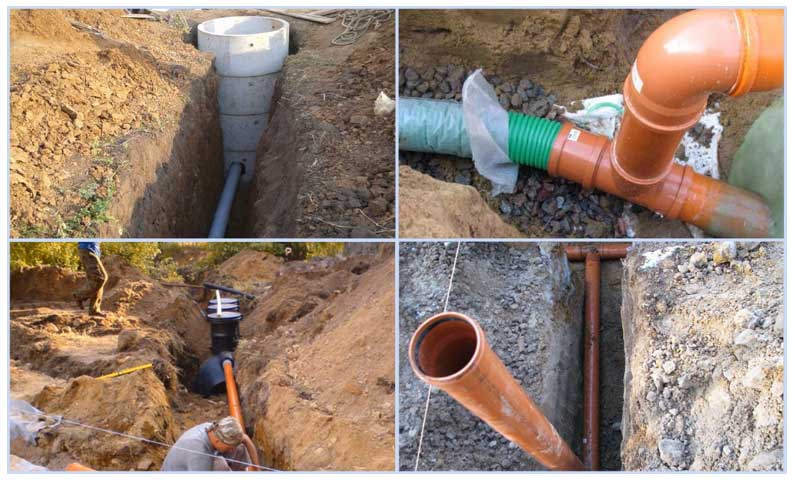
Initially, you will have to dig trenches under the collector. They are dug from the very exit of the pipe from the house and up to the intended location of the septic tank. The depth of digging depends on the level of soil freezing in the region, as a rule, it is at least 70-90 cm. The upper edge of the laid pipe should be at this mark from the soil surface.
During the digging of trenches, the slope specified by SNiP is observed. The final receiver of wastewater should be located below the exit of the sewer pipe from the house. Then they work like this:
- A pillow of sand is poured at the bottom of the trenches and it is well rammed.
- Pipes are laid on the base, securely connecting them.
- The fully assembled system is checked for leaks. If there are no leaks, the water leaves the house freely, you can backfill the collector. At the same time, the soil is not heavily rammed. It will settle down on its own in time. If necessary, then pour more earth on top.
Septic tank device
 At the final stage of work during the installation of a private sewer, you need to build a home-made septic tank. As the simplest option, you can use a tank in the form of a plastic barrel. Some build a sewage receiver from car tires, concrete rings.Plastic is easier to work with. The principle of installation of a two-chamber septic tank looks like this:
At the final stage of work during the installation of a private sewer, you need to build a home-made septic tank. As the simplest option, you can use a tank in the form of a plastic barrel. Some build a sewage receiver from car tires, concrete rings.Plastic is easier to work with. The principle of installation of a two-chamber septic tank looks like this:
Pits are dug under the tanks in accordance with the parameters of the barrels. At the same time, the depth and width of the pit is increased by 30-40 cm under the base and backfill.
The bottom of the pit is carefully rammed. Pour a sand cushion of moistened sand. It is well sealed.
A wooden formwork is placed on the sand under the first chamber and a concrete solution 20-30 cm thick is poured.
The bottom of the second tank is made drainage. A layer of fine gravel is poured onto a pillow of sand, and broken brick or cobblestone is placed on top.
After the solution has dried, both tanks are placed next to each other.
It is important that there are no distortions.
Both chambers are connected by an overflow pipe at a level of 40 cm from the bottom of the barrels.
A drain/sewage pipe is connected to the first receiver in its upper part. All joints are well sealed.
The tanks are filled with water and only after that they are backfilled with thorough tamping of the soil.
If the barrels are not filled with water, they may subsequently burst in the soil.
The top of the septic tank chambers is covered with hatches.
Connecting the house to the sewer where to start
The sewer connection is divided into two types. They are separate and mixed. Separate is used in cases, storm and household connections. But mixed, it is used only with a mixed type pipeline.
It is worth noting that the developer himself finances the sewer input. This process is associated with large sums. But if the owner of the house does not have that kind of money, then there is an opportunity to save. In this case, you will have to upgrade the centralized branch. First of all, the owner is obliged to contact the water utility and offer his cooperation, that is, a certain fee for the work. If the institution confirms your application, then part of the amount of money will be paid by the organization itself. However, you can pay the money by agreement with the neighbors. If they are satisfied with this method, then it will be much easier for you to cope with the task.
Many people do not like to do troublesome business and prefer not to go to various institutions. There is an optimal solution. You can contact the company where they deal with these cases, provide all the documents and draw up an agreement. They will do everything for you. Just before you trust the company, you need to clarify whether they are ready to cope with the task. Do not forget that all services are quite expensive. Therefore, if you do not have sufficient funds, then you should not apply.
We connect the sewerage to a private house
Before starting the construction of their own residential building, each owner is always faced with a number of different problems. First of all, it is necessary to create the correct design of the object and subsequent installation work. If the residential area is located in an area where centralized communication networks have not been built, then you will have to take measures and build an autonomous version. Connecting an autonomous sewer type will require money and time. If the owner builds his house near centralized networks, then there is an excellent opportunity to connect the system to the city sewer. This is the most profitable option.
Designing and carrying out the necessary calculations
 Before starting the construction of the system, you need to draw a preliminary scheme for installing the sewer. The drawing marks all the points of location of plumbing in the house and the location of the septic tank on the site. In addition, the diagram shows the place where the pipeline exits through the foundation into the ground under the first floor. All collector lines are applied to the drawing from each plumbing point and up to the entrance to the septic tank. Produce measurements of the length of each segment of the pipeline. Thanks to the measurements, the total amount of the required footage of external and internal pipes is obtained.
Before starting the construction of the system, you need to draw a preliminary scheme for installing the sewer. The drawing marks all the points of location of plumbing in the house and the location of the septic tank on the site. In addition, the diagram shows the place where the pipeline exits through the foundation into the ground under the first floor. All collector lines are applied to the drawing from each plumbing point and up to the entrance to the septic tank. Produce measurements of the length of each segment of the pipeline. Thanks to the measurements, the total amount of the required footage of external and internal pipes is obtained.
It is extremely important to mark on the drawing all the places of bends, connections, branches and turns of the collector.So the master will be able to purchase the required number of adapters, fittings, etc.
Stages of a sewerage device in a private house
If you would like to independently install the sewerage system in a private house by connecting to the central system, then the following steps should be taken:
- you need to use the services of a surveyor to draw up a situational plan for your site, including a plan for the house itself and marking the path along which the sewer line will be laid;
- file an application with the relevant organization for the development of technical conditions for wastewater disposal at your site;
- these technical specifications should be passed to the design specialists who will develop a project for introduction into the central sewerage system. The finished project must be submitted for approval to the architect and to the water utility service;
- the architect must issue a permit for the work to be carried out by a specific organization;
- it is also necessary to obtain the consent of your neighbors to carry out work near their homes to connect to the central sewer;
- if the destruction of the road surface is envisaged in the course of work (in the event the route passes through it), then it is necessary to obtain the appropriate permits from the traffic police, as well as from the road maintenance service;
- before putting the line into operation, it is necessary to warn the operating service of the water utility;
- upon completion of the sewerage installation, the operating organization must accept the finished project and sign an agreement with you regulating the acceptance of wastewater from you.
When laying sewer pipes, it should be remembered that the pipe should run at a depth of 1200 mm from the house, and the slope should be approximately 5 mm per linear meter.
Storm sewer - connection to the city storm network
Many owners of private cottages would like to divert rainwater from their plots together with domestic wastewater. Technically, this is completely simple, but directing rainwater into sewer wells is strictly prohibited.
This method can easily lead to the overflow of the well, due to which a large amount of sewage will come out. Therefore, in order to free the site from accumulated rainwater, it is necessary to carry out not only the installation of sewage in a private house, but also the connection to the central or city storm sewer. Since storm sewers have a much greater capacity, then rainwater flows will not create an excessive load for it. The rainwater pipe can lead directly to the collector.
Keep in mind that during heavy rains, water can go back through the sewer, so when connecting to the central storm sewer system, you must also install a return valve.
Installation of an autonomous storm sewer in a private house
The most practical way is to arrange a special pit with a reservoir for rainwater runoff in the area. A similar system can also be used as a local sewer for a summer residence. The reservoir is located in the soil, and therefore there is a natural cooling that prevents the growth of bacteria. Then a drain is laid, through which rainwater from the roof of the house will fall into the tank. It is also advisable to put a special grate that will work as a filter and keep leaves, branches and other debris out of the tank.
The water accumulated in the tank can then be used, for example, for irrigation.
Types of sewer systems for a private house
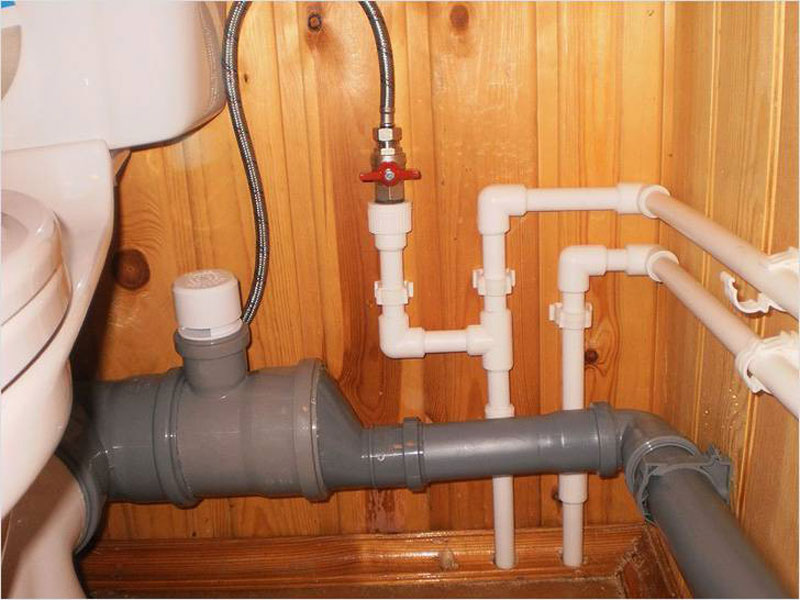
Taking into account the fact that the pipeline will not be connected to the city's central highway, the owners of private plots are building one of the types of sewerage near the house:
- A single-chamber septic tank is a cesspool with a sealed bottom and walls.Provided that the tank is completely filled, it is necessary to pump out sewage with sewage equipment. You can make a drainage / filtering bottom at a single-chamber septic tank. So the water will go into the ground. But here you should be careful: if the groundwater level is high in the area, there is a risk of contaminating nearby drinking wells. Such actions are punishable by law.
- Double septic tank. It consists of two adjacent reservoirs. The first has a larger volume than the second. The sewage flows through the collector to the main receiver, where they are settled. Large particles of garbage (faeces, paper) settle on the bottom. The clarified water is poured into the second tank and drains into the ground there. The bottom of the second drive is made of filter sand and gravel. To avoid its silting, it is better to change the embankment every 4-5 years. The first tank is cleaned every 1-2 years.
- Biological septic tank. Here, bacterial preparations are used to process sewage into organic matter - silt and water. Such a tank must be connected to electricity, since bacteria only work in conditions of positive temperature.
Independent sewerage device
For the internal system you need:
- pipeline
- riser and fan pipe
- revisions
- locking elements
- outlet (connection to an external system).
best place to stand
The first step is piping from each appliance to the riser. The diameter of the pipe at the bath, shower, sinks and sinks is 50 mm, at the toilet bowl - 100 mm. All plumbing fixtures have knees that prevent unpleasant “aromas” from the sewer from entering the premises. When installing and fixing the pipeline, it is necessary to take into account the slope (approximately 3 mm per meter). The riser is displayed above the ridge and covered with a grate. The opening for the outlet to the external pipeline should not be less than 30×30 cm.
The outer part of the sewer consists of:
- pipeline
- wells
- storage tank or septic tank.
A pipeline located above the freezing level is best installed from cast iron. The use of plastic materials is allowed when buried below the freezing level. In a system without a pump, the pipeline is laid with a slope
It is important that the sump or septic tank is located no closer than 5 m from a residential building and 20 m (at least) from a drinking water well. In addition, it is necessary to provide free access for the sewer truck
pipeline is installed and installed.
The size of the pit for the septic tank should be larger than the capacity (so that you can create a concrete pad at the bottom). In this case, the neck of the container at the end of the work should be located slightly above the ground level. The spaces between the septic tank and the walls of the pit are filled with a cement-sand mixture and compacted. After connecting the pipes to the septic tank and checking the tightness and functionality, all trenches are filled up.
It is more convenient to install a system for collecting melted and storm water separately. This will allow not to increase the volume of the septic tank. In addition, melt and rain water is much cleaner than domestic wastewater, so it can be used for technical needs (for example, irrigation).
First you need to make markings on the surface and dig trenches for outlets and pipes (taking into account the slope), as well as holes for storm water inlets. The trenches for the outlets are concreted, a sand cushion 10 cm thick is arranged at the bottom of the trenches for the pipes. Water collectors must be equipped with funnels that are closed with nets. All elements of the storm system are connected.
The cost of connecting the sewerage system of a private house to the general network depends on the cost of processing all the necessary documents, the amount of materials and their type, the cost of the installation contractor. Depending on the region, the total amount varies between 50-150 thousand rubles. The cost of an autonomous system can range from 500 thousand to 1.5 million rubles.To save money, you can build one system for several houses.
https://youtube.com/watch?v=4IbYUyWsWV8
Types of sewerage for a private house
Any drainage system consists of two parts: internal and external. The first is designed to collect water from various plumbing fixtures. The second most often also consists of two parts: household and storm sewers. The first one removes excess water from the roofs of a residential building and other buildings, platforms and paths. The second collects wastewater from a residential building. It consists of:
- pipeline;
- pumps;
- filters;
- wells and drain pits;
- filter wells or septic tank.
gravity or forced circulation. depends on the power supply
The stormwater and household systems are sometimes combined into one and are called a common sewage system. But most often, storm and melt water is discharged separately from domestic wastewater. Such external sewerage is called separate.
Sewer installation materials
Internal sewerage consists of plumbing fixtures and pipelines, which are most often mounted from plastic materials. Not only pipes are required, but also various fittings:
- bends;
- knee;
- tees;
- crosses.
For all plumbing fixtures, you need to purchase devices that prevent the penetration of solid particles into the system. The pipeline is mounted with a slope, that is, the entry into the riser must be located below the sections connected to the plumbing fixtures.
collection and cleaning system. drain pitspecial sealed container
On sandy soils, filter wells can be built from concrete rings by filling a layer of crushed stone at the bottom of the pits. Such structures are not filled very quickly, but they only clean 60-70% of wastewater. Septic tanks are much more efficient, in which wastewater is cleaned with the help of aerobic and anaerobic bacteria and enters the filtration well with a layer of gravel (crushed stone) at the bottom. When using a septic tank, domestic sewage is cleaned almost completely and does not harm the environment.
The piping for the outside can be made of cast iron or plastic (PVC, polypropylene, corrugated polyethylene). Cast iron is too expensive, heavy and requires the involvement of heavy equipment. Plastic materials are light, very smooth inside, resistant to rust. For domestic piping, the best option is PVC pipes or corrugated polyethylene. But the choice is made on the basis of soil analysis, the level of soil freezing in winter, the area of \u200b\u200bthe site and the type of cleaning system.
